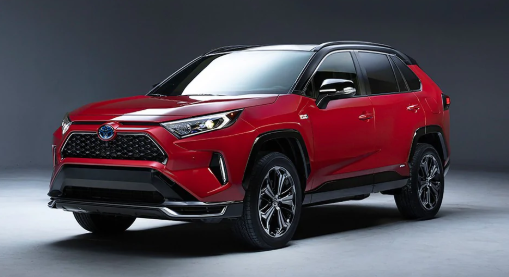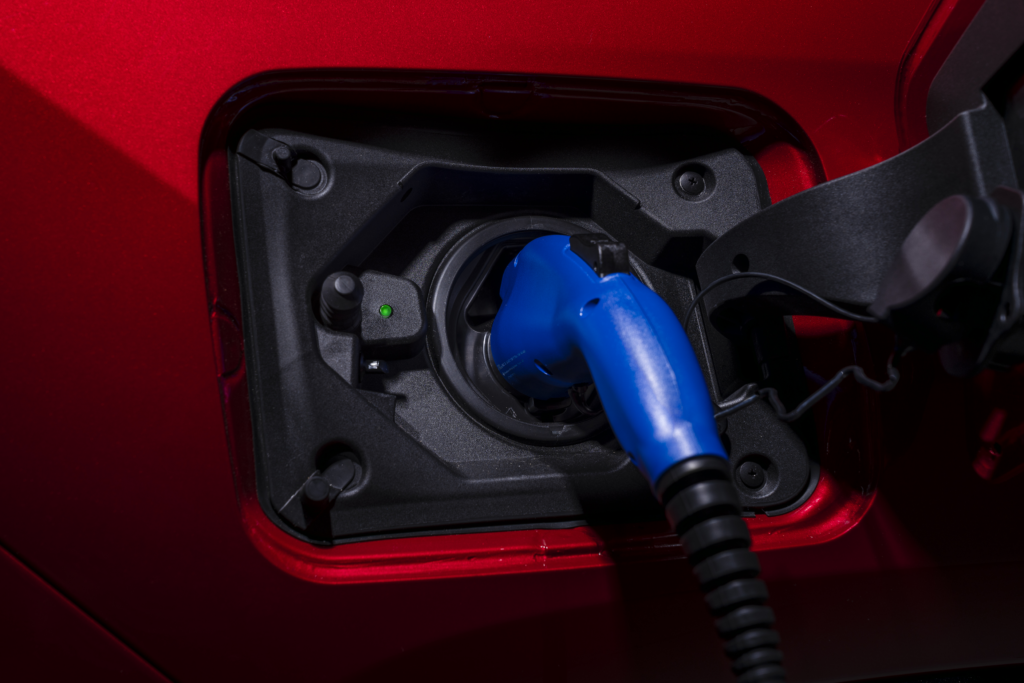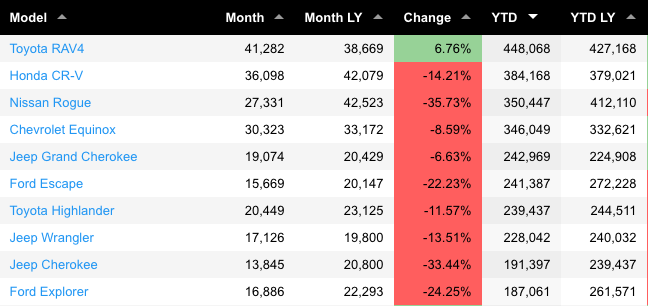The short answer is yes and no.
In 2019 the Toyota RAV4 Hybrid outsold the entire Prius family of models by roughly 22,500 units (92,595 to 69,718). And in the summer of 2020 Toyota will launch the RAV4 Prime plug-in hybrid (PHEV) version of the popular and number four selling vehicle in the US.

Why The RAV4 Prime Should Sell Well
While all the details are not yet in, the RAV4 Prime PHEV appears to be a very strong offering from Toyota and I expect it to sell extremely well in the US for several reasons:
Range: With 39 miles of range, only the Honda Clarity has more range at 47 miles. (Note: Later in 2020 the high-priced Polestar 1 (65) and Karma Revero GT (61) will have higher EPA range). The average and median range of PHEVs available in the US is around 22 miles and is frankly underwhelming and not that valuable unless you only drive a few miles to work, school or errands each day. At 39 miles, a large majority of Americans can commute one of both ways to and from work (charging at or near work).
Performance: With 302 horsepower and 0 to 60 mph in an estimated 5.8 seconds, Toyota is billing the RAV4 Prime as a performance vehicle.
And so, in addition to an ability to do 0-60 mph in a projected 5.8 seconds, which is the second quickest acceleration time in the Toyota lineup, it can drive an estimated 39 miles on battery alone on a single charge, which is the highest EV range of any PHEV SUV on the market. The RAV4 Prime also has a manufacturer-estimated 90 combined MPGe.
Source: Toyota Press Release

Available Federal Tax Credit: To achieve a range of 39 miles, the RAV4 Prime likely has at least a 16 kWh battery pack. If so, it would qualify for the full $7,500 federal tax credit. Additionally, in California it would qualify for a $1,000 rebate and in some other states $500 or more in incentives. Additionally, many utilities offer rebates of $500 or more.

Gas savings: Toyota has not yet released the RAV4 Prime’s MPG rating, but according to Edmunds it should come close to the regular RAV4 Hybrid’s rating of 40 mpg combined (41 city/38 highway). At an 38 MPG combined, the RAV4 Prime would have a roughly 10 MPG advantage over the 28 mpg combined rating of non-hybrid RAV4 with all-wheel drive.
Between driving a majority of annual miles using lower cost “electric fuel” and less gasoline when driving on the internal combustion engine, the Prime likely saves a few thousand dollars per year over the regular, non hybrid version.

Price Delta: While Toyota has yet to reveal pricing of the RAV4 Prime, if it is within about $5,000 of similarly equipped regular and hybrid versions, it should be a no brainer for most buyers to opt for the Prime. Toyota is only offering the Prime in the SE and XSE trim levels.
For comparison, the RAV4 XSE Hybrid starts at an MSRP of $34,050, so a Prime XSE starting at or under $40,000 should position it well with the available EV incentives. Between the various incentives and gas savings listed above, the Prime should have a net lower effective cost than the hybrid or non-hybrid versions of the RAV4.
It’s an SUV: SUVs, crossovers, pickups and vans (a category known as “light trucks”) accounted for 72% of US vehicle sales in 2019. The RAV4 is in one of the hottest segments that bridges small SUVs and CUVs. in 2019, SUVs and CUVs combined for 48.9% of US light vehicle sales, according to Wards Auto.

High Sales Overall: In 2019, the RAV4 was the number four selling vehicle in the US, with nearly 450,000 units sold. Sales of the RAV4 Hybrid model were up 92.3% from 2018. The only vehicles that outsold the RAV4 in 2019 were three pickups: the Ford F150, Ram Pickup, and Chevrolet Silverado.
So just by the nature of the RAV4’s popularity and sales volume, if 10% (one in 10) of the people that walk into a Toyota dealer with the intent to buy a RAV4 drive off in the Prime, that means roughly 45,000-50,000 units would be sold per year.
According to the InsideEVs Sales Scorecard, since 2010, only two electric vehicles have sold more than 30,000 vehicles in a year – the Nissan LEAF in 2014 and Tesla Model 3 in both 2018 and 2019. The Toyota Prius Prime, however, was a top-selling EV the last 3 years: 2017 (20,936), 2018 (27,595) and 2019 (estimated 20,000).
Experienced Toyota Dealers: One of the biggest known challenges with EV sales in the US is the lack of EV knowledge among sales staff. Several secret shopper studies have shown that dealers often haven’t charged EVs, sales staff can’t answer basic questions about charging, don’t know where their EVs can be charged, frequently provide incorrect information, and often try and steer buyers away from EVs.

Toyota dealers have been selling a plug-in hybrid version of the Prius since 2012 and regular hybrids since 2001. This experience with “electrified” vehicles and greater knowledge of EVs should lead to solid enthusiasm and fewer dealer missteps in selling the RAV4 Prime.
So, Is The RAV4 Prime the “New Prius”?
As I stated at the beginning of this article, the answer to this question is both “yes” and “no.” Let’s look at why:
Yes: The original Prius became synonymous with regular gas hybrids and popularized this more gas-efficient power train category. For many years the Prius was the number one selling hybrid in the world and if you wanted to signal to your neighbors that you were green and cared about the planet, the Prius was your top option.
That was at least until electric vehicles like the Nissan LEAF and Chevrolet Volt, and more recently the Tesla Model 3 emerged and took the crown for green signaling and conspicuous conservation.
With crossovers and SUVs dominating sales and plug-in hybrids also seeming to be on the rise, the RAV4 Prime could be the dominant selling plug-in hybrid in the US for the next several years. In essence, both its plug in aspect and being an SUV makes it the “new Prius.”
No: While the RAV4 Prime will likely become the dominant plug-in hybrid in the US, analogous to the Prius regular hybrid dominance, it will lack the highly recognized, but divisive green signaling image. The RAV4 Prime is just a modified version of the regular RAV4 that looks normal and is not very distinctive nor polarizing.
Another aspect of the Prius’ image is that it was one of the first hybrids and also, until a few years ago did not have a lot of competitors. The RAV4 Prime, however, will be available 10 years after the Chevrolet Volt PHEV and by the end of 2020 there should be lots of competition with an estimated 38 PHEVs available in the US.
What do you think, will the RAV4 become the new Prius or will it just be another PHEV in the crowd?




9 Responses
I didn’t buy a 2016 Prius to do any green signaling. I bought it because it was proven to be a reliable, highly economical hatchback, especially if you drive a lot of miles. It has been great and has 85,000 mile in 42 months. The RAV4 Prime is even better and it will be easier on my baby-boomer knees to exit. Standard eAWD is a plus as I hope to travel in places where it may snow unexpectedly. It will propel electric only most days, then do well on trips and with no range anxiety. Oddly enough, it has nearly the same footprint as the Prius, which is a much bigger car than people tend to think it is. It should sell well.
Exactly. Same footprint as the Prius, but taller and 39 miles of electric power plus 302 hp when you need or want thrust.
The RAV4 Prime seems to be in the current sweet spot due to being a small SUV, enough EV range for most uses, zero range anxiety, great acceleration, reasonable price point.
If you add that it’s based on the most popular vehicle outside of a pickup and it’s from Toyota with it’s Hybrid pedigree and well deserved reputation for quality, it’s a low risk proposition for many.
I think the other PHEV manufacturers may be wishing it didn’t exist.
Yep, the RAV4 and RAV4 Prime have a lot going for it – the key will be what kind of supply will Toyota provide US dealers?
As a 2008 V6 Rav4 owner, I just want to add that this is the vehicle A LOT of us have been waiting for. Energy efficient with enough engine zip. The reliability of my current Rav4, with 230,000+ miles and virtually no problems, will have me sticking with Toyota’s best upcoming version of the Rav4.
Will the Rav4 Prime be able to turn of the ev mode until you get to the city then be able to turn it back on, so that you can get the advantage of the 39 miles? Basically as the Honda Clarity PHEV can. Also will the car charge the big battery while driving to some extent as the Clarity can? Also will it have low speed interactive driving as the Clarity can? These answers will make my decision on which car to purchase this summer.
I thought that one of you experts would be able to assist me with this info. I guess not. Sorry I bothered you all.
Yes to all, except last.
I’m in my late 60s’ with a bad back, and been looking for something small. Easy to get in and out of along with good gas mileage. Basically Ford C Max was the only thing available until they quit making it in the US. This Toyota RAV4 prime seems to fill that void, hopefully it’s comfortable and it comes in different colors, like white!